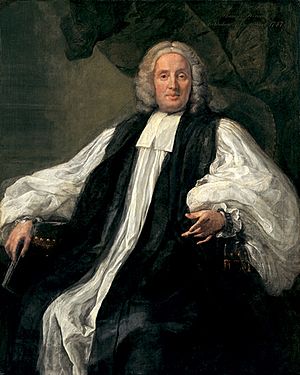Thomas Herring facts for kids
Quick facts for kids The Most Reverend and Right Honourable Thomas Herring |
|
|---|---|
| Archbishop of Canterbury | |

Portrait by William Hogarth
|
|
| Church | Church of England |
| Diocese | Canterbury |
| In Office | 1747–1757 |
| Predecessor | John Potter |
| Successor | Matthew Hutton |
| Orders | |
| Consecration | 15 January 1738 by John Potter |
| Personal details | |
| Born | 1693 Walsoken, Norfolk, England |
| Died | 23 March 1757 (aged 63-64) Croydon, London, England |
| Nationality | English |
| Denomination | Anglican |
| Parents | John Herring & Martha Potts |
| Previous post | Bishop of Bangor (1737–1743) Archbishop of York (1743–1747) |
| Education | Wisbech Grammar School |
| Alma mater | Jesus College, Cambridge |
Thomas Herring (born 1693, died 1757) was an important leader in the Church of England. He became the Archbishop of Canterbury, which is the highest position in the Church, serving from 1747 to 1757. He was known for his strong support of the British government and his efforts to unite people during challenging times.
Contents
Early Life and Learning
Thomas Herring was born in 1693 in Walsoken, Norfolk, England. His father, John Herring, was a church leader (rector) in Walsoken. His mother was Martha Potts.
Thomas went to Wisbech Grammar School for his early education. Later, he studied at Jesus College, Cambridge. He started his studies in 1710 and earned several degrees, including a Bachelor of Arts and a Master of Arts.
In 1714, he moved to another college, Corpus Christi College, Cambridge. There, he was a fellow (a kind of teacher or researcher) from 1716 to 1723. He also earned a Doctor of Divinity degree in 1728. Interestingly, another future Archbishop, Matthew Hutton, studied at Cambridge at the same time. Matthew Hutton would later take over Thomas Herring's roles in different church areas.
His Career in the Church
Thomas Herring became good friends with Philip Yorke. Philip Yorke was a powerful lawyer who later became the Lord Chancellor, a very important legal official in Britain. This friendship helped Thomas Herring advance quickly in his career.
In 1727, he became a chaplain to King George II. This meant he was a special priest serving the King. In 1732, he became the Dean of Rochester. Then, in 1737, he was appointed Bishop of Bangor, a church leader in Wales. He was officially made a bishop on January 15, 1738.
Archbishop of York
On April 21, 1743, Thomas Herring was given an even more important role. He became the Archbishop of York, a major leader in the Church of England.
In 1745, a big event happened in Britain called the Jacobite rising. This was when supporters of a different royal family tried to take over the throne. During this time, Thomas Herring gave a very powerful speech. This speech encouraged people to support the King and their country.
The speech was so good that Horace Walpole, a famous writer, said it had "true spirit, honesty and bravery." When the Lord Chancellor, Philip Yorke, told King George II about the speech, the King was very impressed. He ordered the speech to be printed for everyone to read and personally thanked Archbishop Herring for his efforts.
Herring helped organize people in Yorkshire to resist the Jacobites. He helped raise volunteers and money to protect the country. He believed that supporting the King and his family was very important for Britain's safety. He also thought that France, a Catholic nation, was a threat to Britain.
Archbishop of Canterbury
On October 21, 1747, Thomas Herring was chosen to be the Archbishop of Canterbury. This is the most senior position in the Church of England. In this role, he often worked closely with his friend, the Lord Chancellor. He sometimes had disagreements with the Duke of Newcastle, who was a powerful government official.
Thomas Herring was known for trying to bring people together. He was happy to be in such a high position during a time when people were more open to different ideas and had more freedom.
He passed away in 1757 and was buried in Croydon Minster in Surrey.

